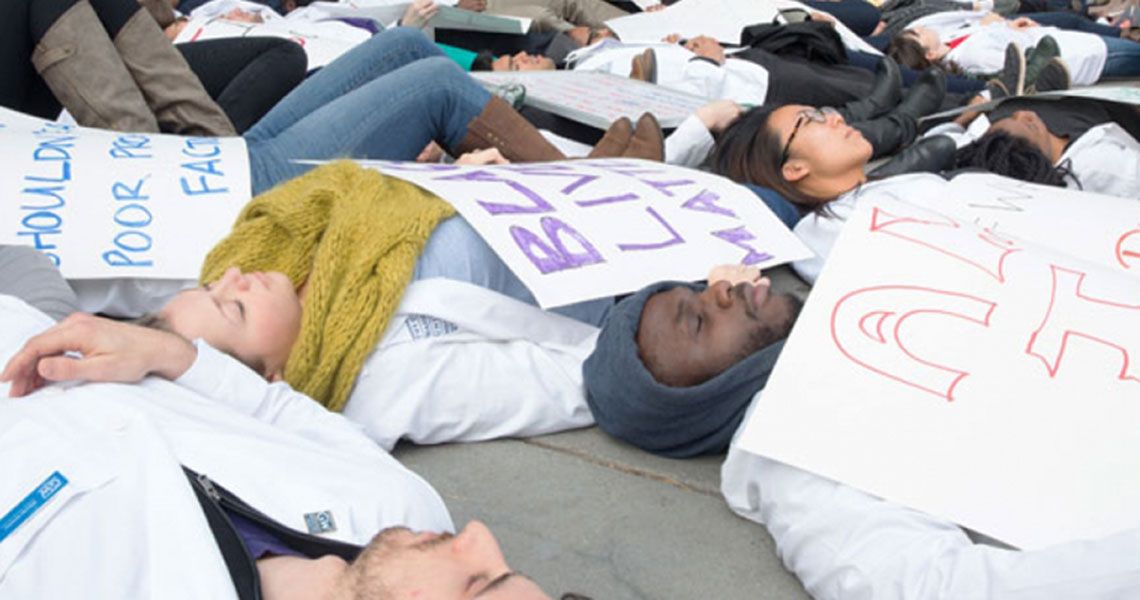They lay motionless on the sidewalk, incongruous in their spotless white medical coats, figures that would have seemed more familiar striding through the corridors of the nearby George Washington University Hospital. They held signs emblazoned with slogans like “First Do No Harm,” “Homicide Is a Public Health Problem” and “Black Skin Shouldn’t Be a Poor Prognostic Factor.”
Commuters emerging from the busy Foggy Bottom Metro station a few feet away streamed around them. Some stopped to photograph. Others paused and stood in silence. One leaned down over the mass of students from the GW School of Medicine and Health Sciences (SMHS) and said, “Thank you.”
The dozens of demonstrators participated Wednesday in a “die-in” to protest the recent deaths of black men at the hands of law enforcement officers. The peaceful effort was part of #WhiteCoats4BlackLives, a coordinated event with more than 2,000 other medical students at 40 medical schools across the country.
Demonstrators first marched in a circuit around the courtyard in front of Ross Hall, chanting, “We can’t breathe”—the last words of chokehold victim Eric Garner, which protestors around the nation have repurposed into a rallying cry against race-based institutional violence. Then, silently, they lay down. They were still for four and a half minutes, representing the four and a half hours during which Michael Brown’s body lay in a street in Ferguson, Mo., after his death.
“It is impossible to address individual health without simultaneously addressing societal health,” said second-year medical student Ruqayyah Abdul-Karim, reading a statement in front of reporters and onlookers at the end of the silent period. Mass incarceration and police brutality are as much the business of the medical community as are issues like literacy and nutrition, she said, adding that black youth between the ages of 15 and 19 are 21 times more likely to be killed by police than are their white counterparts.
“When our nation’s most powerful medical institutions fail to confront the dire effects of police brutality and mass incarceration on the lives and livelihoods of black communities, we become complicit in perpetuating this violence,” she said.
Second-year students, like Ms. Abdul-Karim, took the semester’s final practice of medicine exam Wednesday morning. They emerged, with scarcely a break, into the protest.
Sojung Yi, also a second-year medical student and one of the event’s organizers, said that the exam covered basic principles of medical ethics which were directly relevant to the demonstration.
“Beneficence, non-maleficence, patient autonomy and justice are the basic principles of bioethics,” she said. “Medical students and future health professionals recognize that social justice is a central component of our work. It’s not just about the last few weeks, it’s about injustices that doctors see in their work every day.”
Kent Aje, a first-year student at SMHS, held a sign asking, “Am I Next?”
“Healing is about advocacy, especially for those that are misrepresented and underrepresented,” he said. “And too often it’s minorities who are misrepresented in the justice system, in the health care system, in all aspects [of society]. So for us to be advocates is our profession and our calling. It’s our duty.”
The die-in was the second held on the GW campus. More protests are planned, both in Washington, D.C. and around the country.
Naya Misa, a second-year medical student and a protest organizer, said she and her roommate had participated in another march earlier this month.
“I’d been questioning how much value these protests have,” she said, “but I see they have value in numbers—in disrupting people’s everyday normalcy, forcing people to pay attention, forcing people to understand that this is not going to go away. This is not something people will be upset about for a month and then it will die down. This is injustice, and we all need to care.”
Merrick Tam, a first-year medical student, said that the symbolism of the white physician’s coat carries with it “a responsibility to speak for those who can’t speak.”
“This is medicine,” he said, indicating his fellow protesters. “Standing up is part of medicine.”



